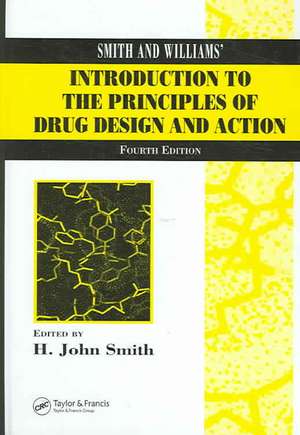Smith and Williams' Introduction to the Principles of Drug Design and Action
Autor H. John Smith, Hywel Williamsen Limba Engleză Hardback – 10 oct 2005
Fully updates and expands the contents
Coverage of agonists and antagonists of neuro-transmitters
Information on the design of stable peptide-like drugs
The human genome and its impact on drug discovery and development
Advances in therapy and pharmacokinetics
Adopting a from-the-bench-to-the-marketplace approach, the book provides a thorough grounding in rational drug design. It emphasizes principles and elucidates a framework for basic drug design into which current and, more importantly, future drugs will fit.
| Toate formatele și edițiile | Preț | Express |
|---|---|---|
| Paperback (1) | 322.85 lei 6-8 săpt. | |
| CRC Press – 24 iun 2024 | 322.85 lei 6-8 săpt. | |
| Hardback (1) | 842.95 lei 3-5 săpt. | +60.28 lei 6-12 zile |
| CRC Press – 10 oct 2005 | 842.95 lei 3-5 săpt. | +60.28 lei 6-12 zile |
Preț: 842.95 lei
Preț vechi: 926.32 lei
-9% Nou
Puncte Express: 1264
Preț estimativ în valută:
161.29€ • 168.41$ • 133.49£
161.29€ • 168.41$ • 133.49£
Carte disponibilă
Livrare economică 14-28 martie
Livrare express 27 februarie-05 martie pentru 70.27 lei
Preluare comenzi: 021 569.72.76
Specificații
ISBN-13: 9780415288774
ISBN-10: 0415288770
Pagini: 682
Dimensiuni: 178 x 254 x 43 mm
Greutate: 1.59 kg
Ediția:4Revizuită
Editura: CRC Press
Colecția CRC Press
ISBN-10: 0415288770
Pagini: 682
Dimensiuni: 178 x 254 x 43 mm
Greutate: 1.59 kg
Ediția:4Revizuită
Editura: CRC Press
Colecția CRC Press
Public țintă
ProfessionalCuprins
Processes of Drug Handling by the Body. The Design of Drug Delivery Systems. Fundamental Pharmacokinetics. Intermolecular Forces and Molecular Modeling. Drug Chirality and its Pharmacological Consequences. Quantitative Structure–Activity Relationships (QSAR) in Drug Design. Prodrugs. From Program Sanction to Clinical Trials: A Partial View of the Quest for Arimidex, A Potent, Selective Inhibitor of Aromatase. Design of Enzyme Inhibitors as Drugs. Peptide Drug Design. Combinatorial Chemistry: A Tool for Drug Discovery. Recombinant DNA Technology: Monoclonal Antibodies. The Human Genome and its Impact on Drug Discovery and Therapy. The Chemotherapy of Cancer. Neurotransmitters, Agonists, and Antagonists. Design of Antibacterial, Antifungal, and Antiviral Agents. Pharmaceutical Applications of Bioinorganic Chemistry. Index.
Recenzii
“This book consists of 17 chapters on a variety of topics related to drug design and action. … This book is intended as a possible text for undergraduate chemistry students interested in medicinal chemistry, or for graduate students as a means to learn the basics of medicinal chemistry. … classical approaches are described for drug design with the inclusion of the more recent context of the human genome project … In summary, some medicinal chemists in academia or the pharmaceutical industry may find this book instructive for certain classes of biomolecules or classical approaches to drug design. It should probably be included in most comprehensive library collections of medicinal chemistry texts and monographs.”
— Bruce L. Currie, Department of Pharmaceutical Sciences, Loma Linda University, California, in Journal of Medicinal Chemistry, , Vol. 50, No. 1, 2007
“The fourth edition of this book includes the latest information on topics such as gene therapy, computer-aided design, and molecular techniques including proteomics. … real-world examples that illustrate the principles of drug design … New features of this edition include: coverage of agonists and antagonists of neurotransmitters; the design of stable peptide-like drugs; the human genome and its impact on drug discovery and development; advances in therapy and pharmacokinetics.”
— In Anticancer Research, Vol. 26, 2006
Promo Copy
— Bruce L. Currie, Department of Pharmaceutical Sciences, Loma Linda University, California, in Journal of Medicinal Chemistry, , Vol. 50, No. 1, 2007
“The fourth edition of this book includes the latest information on topics such as gene therapy, computer-aided design, and molecular techniques including proteomics. … real-world examples that illustrate the principles of drug design … New features of this edition include: coverage of agonists and antagonists of neurotransmitters; the design of stable peptide-like drugs; the human genome and its impact on drug discovery and development; advances in therapy and pharmacokinetics.”
— In Anticancer Research, Vol. 26, 2006
Promo Copy
Descriere
As knowledge of biological systems and the number of techniques available for exploring and visualizing their components has increased, it has become possible to design drugs specifically for a given target. Smith and Williams’ Introduction to the Principles of Drug Design and Action, Fourth Edition provides the basic principles of rational drug design, including both novel and established approaches. This new edition adopts a from-bench-to-marketplace approach, using real examples where possible. It offers a comprehensive update of the previous edition, particularly with respect to new advances in molecular techniques, biotechnological applications, and computer-aided design.





